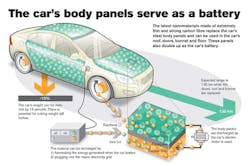Volvo Car Group Embeds Batteries, Supercaps in Carbon Fiber Body
Volvo Car Group has developed a revolutionary concept for lightweight structural energy storage components that could improve the energy usage of future electrified vehicles. The material, consisting of carbon fibre, nano structured batteries and super capacitors, offers lighter energy storage that requires less space in the car, cost effective structure options and is eco-friendly.
The project, funded as part of a European Union research project, included Imperial College London as the academic lead partner along with eight other major participants. Volvo was the only car manufacturer in the project. The project team identified a feasible solution to the heavy weight, large size and high costs associated with the batteries seen in hybrids and electric cars today, while maintaining the efficient capacity of power and performance. The research project took place over 3.5 years and is now realized in the form of car panels within a Volvo S80 experimental car.
The answer was found in the combination of carbon fibres and a polymer resin, creating a very advanced nanomaterial, and structural super capacitors. The reinforced carbon fibres sandwich the new battery and are moulded and formed to fit around the car’s frame, such as the door panels, the boot lid and wheel bowl, substantially saving on space. The carbon fibre laminate is first layered, shaped and then cured in an oven to set and harden. The super capacitors are integrated within the component skin. This material can then be used around the vehicle, replacing existing components, to store and charge energy.
The material is recharged and energized by the use of brake energy regeneration in the car or by plugging into a main electrical grid. It then transfers the energy to the electric motor which is discharged as it is used around the car.
The breakthrough showed that this material not only charges and stores faster than conventional batteries can, but that it is also strong and pliant.
Today, Volvo Car Group has evaluated the technology by creating two components for testing and development. These are a boot lid and a plenum cover, tested within the Volvo S80.
The boot lid is a functioning electrically powered storage component and has the potential to replace the standard batteries seen in today’s cars. It is lighter than a standard boot lid, saving on both volume and weight.
The new plenum demonstrates that it can also replace both the rally bar, a strong structural piece that stabilizes the car in the front, and the start-stop battery. This saves more than 50% in weight and is powerful enough to supply energy to the car’s 12 Volt system.
It is believed that the complete substitution of an electric car’s existing components with the new material could cut the overall weight by more than 15%. This is not only cost effective but would also have improvements to the impact on the environment.
Electrified cars play an important role in Volvo Car Group’s future product portfolio and the company will continue to find and develop innovative and advanced technical solutions for the cars of tomorrow.
Participants
1. Imperial College London ICL United Kingdom (project leader)
2. Swerea Sicomp AB, Sweden
3. Volvo Car Group, Sweden
4. Bundesanstalt für Materialforschung und-prüfung BAM, Germany
5. ETC Battery and FuelCells, Sweden
6. Inasco, Greece
7. Chalmers (Swedish Hybrid Centre), Sweden
8. Cytec Industries (prev UMECO/ACG), United Kingdom
9. Nanocyl, NCYL, Belgium
About the Author

Sam Davis Blog
Editor-In-Chief - Power Electronics
Sam Davis was the editor-in-chief of Power Electronics Technology magazine and website that is now part of Electronic Design. He has 18 years experience in electronic engineering design and management, six years in public relations and 25 years as a trade press editor. He holds a BSEE from Case-Western Reserve University, and did graduate work at the same school and UCLA. Sam was the editor for PCIM, the predecessor to Power Electronics Technology, from 1984 to 2004. His engineering experience includes circuit and system design for Litton Systems, Bunker-Ramo, Rocketdyne, and Clevite Corporation.. Design tasks included analog circuits, display systems, power supplies, underwater ordnance systems, and test systems. He also served as a program manager for a Litton Systems Navy program.
Sam is the author of Computer Data Displays, a book published by Prentice-Hall in the U.S. and Japan in 1969. He is also a recipient of the Jesse Neal Award for trade press editorial excellence, and has one patent for naval ship construction that simplifies electronic system integration.

